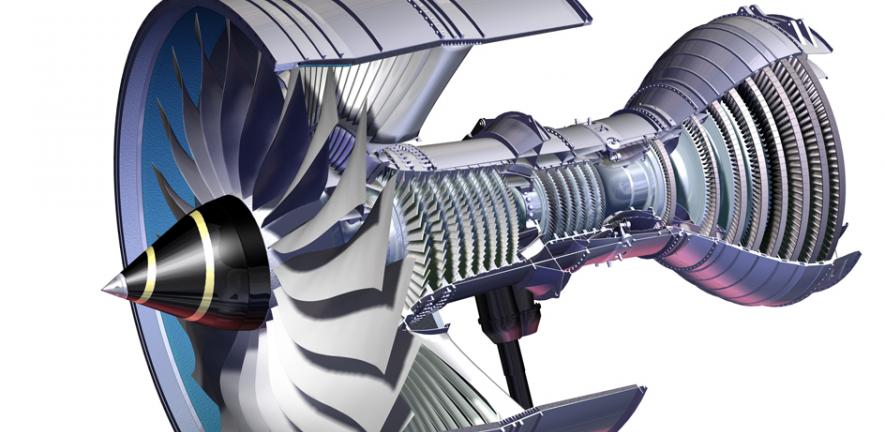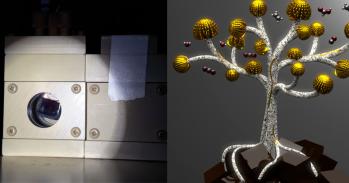
Only a single class of engineering materials can withstand the extreme conditions deep within a jet aeroplane engine – the nickel-base superalloys.
Only a single class of engineering materials can withstand the extreme conditions deep within a jet aeroplane engine – the nickel-base superalloys.
It’s about building a relationship of trust between the researchers and the industrial partner to mutual benefit.
Dr Cathie Rae
By improving the performance of materials used in these highly demanding environments, jet engines can be run at higher temperatures. And, because this reduces fuel consumption, increasing gas temperatures offers a direct method by which emissions from air travel can also be reduced. The Cambridge team conducts research into all aspects of the metallurgy of these materials, from understanding how their properties may be optimised, to ensuring their safety in service, to investigating why failures occur.
The Cambridge Materials UTC was linked five years ago with complementary departments at the Universities of Swansea and Birmingham to form a UTP. ‘The UTPs have been very much admired throughout the world, and other companies globally are beginning to emulate the model of having permanent research centres within universities,’ said senior academic Dr Cathie Rae. ‘It’s about building a relationship of trust between the researchers and the industrial partner to mutual benefit.’
With an eye on the future, the lab is now also working towards the development of novel materials to enable more efficient aeroengines to be realised. ‘We cover the longer range research area that Rolls-Royce needs,’ explained Director Professor Colin Humphreys, who masterminded the original UTC and leads the Cambridge UTP. ‘We’ve helped to develop new alloys that are currently flying in Rolls-Royce-powered aircraft and now we’re developing their successors – the alloys of the future – which will run hotter, stronger, for even longer.’
For more information, please visit www.msm.cam.ac.uk/UTC
Rolls-Royce
Research is the foundation stone for the high-technology products that Rolls-Royce designs and develops for its extremely competitive aerospace, marine and energy businesses. Each market sector sets substantial economic, operational and environmental challenges that call for accurate, long-range, research-based, technology planning.
Rolls-Royce, in collaboration with its partners, spends around £800 million annually on research and development. Its research strategy embraces three ‘Visions’ addressing the 5-, 10- and 20-year timeframes, which broadly are devoted to technology validation, applied research and fundamental research, respectively.
A key element of the longer-range Vision 10 and Vision 20 programmes is the network of Rolls-Royce-supported University Technology Centres (UTCs). Over the past 18 years, some 29 UTCs (20 in the UK, the remainder in Europe, USA and Asia) have been carefully selected as the very best in their fields to address critical technical areas as diverse as materials, noise, combustion, aerodynamics and manufacturing technology. In cases where UTCs are highly complementary in their research focus, they have been linked together to form University Technology Partnerships (UTPs).
The University of Cambridge, with which Rolls-Royce has deep and long-established research links, has played a key role in the UTC network through three research programmes:
- The Cambridge University Gas Turbine Partnership (UGTP) includes the world-renowned Whittle Laboratory and over 80 projects, such as the Environmentally Friendly Engine (see panel), whose collective purpose is to provide an integrated approach to gas turbine fluid mechanics and thermodynamics.
- The Materials UTC in the Department of Materials Science and Metallurgy conducts research into high-temperature superalloys used in the hottest components of gas turbine engines (see panel).
- The Engineering Design Centre (EDC) in the Department of Engineering has provided the Engineering Knowledge Management UTC of a wider UTP for Design. The project addressed the need to capture, store and retrieve engineering knowledge to improve design processes.
The UTCs and UTPs are highly regarded as models for effective industrial– academic collaborative research. Their long-term nature and real-world challenges bring mutual benefits: Rolls-Royce finds solutions to complex technical challenges; the universities gain an ongoing five-year stability of funding and a greater depth and quality to their academic research; and the science base is broadened by developing a strong pool of highly skilled engineers and scientists.
This work is licensed under a Creative Commons Licence. If you use this content on your site please link back to this page.





